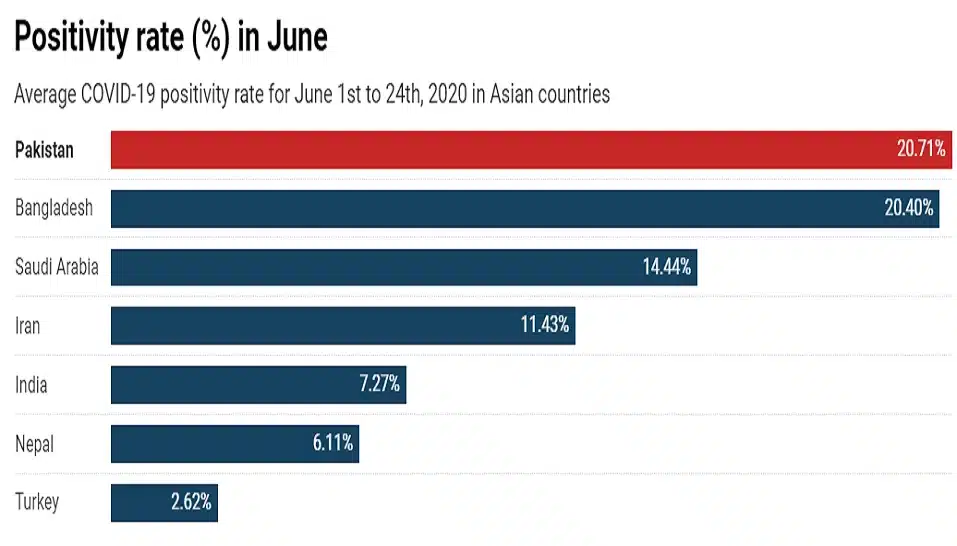Is the spike in positive cases only because of increased testing? At 0.13 tests per thousand people, the WHO recommends that Pakistan increase its testing capacity by over 75 percent.
On 11th June 2020, Pakistan observed its highest single-day spike in COVID-19 cases, with a total of 6,397 new cases being recorded in 24 hours. Incidentally, on the same day, Pakistan’s Ministry of National Health Services also reported having conducted its highest number of daily tests – 28,344.
There is an inclination to attribute this spike to an increase in the number of tests conducted. The percentage of positive cases – the positivity rate – out of the total tested on 11th June was 20.7 percent. Data shows that 20.7 percent was actually the lowest daily positivity rate for Pakistan that week.
Pakistan’s positivity rate has been surging since the nationwide lockdown ended on 9th May, till it peaked around mid-June, and has only begun to show a downward trend since 18th June.
Number crunching
Pakistan imposed a nationwide lockdown on 1st April when the country had 2039 confirmed cases. One-fifth of the total cases were recorded on the day the lockdown began. After a period of 39 days – and two extensions – the government decided that Pakistan could no longer bear the burden of an economic standstill. It shifted to a “smart” lockdown model in which only hotspots in certain areas of Punjab and Khyber Pakhtunkhwa would remain under strict lockdown.
When the lockdown ended on 9th May, Pakistan’s total cases had grown to 13.47 times its pre-lockdown number, while its testing capacity had expanded to 15.67 times since 1st April. The positivity rate was definitely on an upward trend but towards the end of the lockdown, the slope had begun to flatten.
A couple of weeks after the lockdown ended, however, Pakistan’s COVID-19 positivity rate began to skyrocket, peaking at 22.4 percent on 4th June, maintaining an average of 20.71 percent for the month so far. Since 18th June, a downward trend in the positivity rate has been observed. However, it is too soon to tell whether this trend indicates a permanent fall in the statistic or it is simply a fluctuation.
What does a high positivity rate mean?
The Coronavirus Resource Center at Johns Hopkins University infers that a high positivity rate suggests that a country simply isn’t testing enough, as only those who are ill, symptomatic, or suspected cases are seeking medical attention, and are getting tested. In Pakistan’s case, the WHO validates this inference in their Office for the Coordination of Humanitarian Affairs (OCHA) situation report on 10th June, by recommending that the government increase its testing capacity to 50,000 daily tests – over 75 percent greater than its current value – in order to “assess the actual prevalence of coronavirus across the country.”
A high positivity rate also means that from a public health perspective, the country should still be in lockdown. According to WHO guidelines, countries should only end their lockdown once they have observed a positivity rate lower than five percent for a period of two weeks. Pakistan’s positivity rate on 9th May was 12.3 percent and hadn’t dipped below five percent since early April when testing was largely non-existent.
Compare & contrast
Among its neighbouring countries with a similar population and COVID-19 curve, Pakistan has had the highest average positivity rate for the first half of June. The only other Asian country nearing Pakistan’s figure is Bangladesh – which is not surprising as its number of tests per thousand people is 0.10, even lower than Pakistan’s 0.13.
India, too, is testing a lower proportion of its population than Pakistan at 0.12 tests per thousand people. Despite this, its positivity rate is a little over a third of Pakistan’s and Bangladesh’s, indicating that testing capacity is not the only factor influencing a country’s positivity rate.
Another key variable at play is social distancing behaviours and awareness about public health. In Bangladesh, despite lockdown being in place, hundreds of garment factories had reopened in late April, ignoring necessary social distancing and sanitation measures. The WHO cited the need for Pakistan to strengthen its public health, sanitation, contact tracing, and social distancing in its latest situation report.
Going forward, the WHO also recommended that Pakistan implement a two-weeks ‘on’ and two-weeks ‘off’ lockdown to minimise the trade-off between economic activity and public health. As of now, Pakistan plans on continuing with its ‘smart lockdown’ and expanding it to 500 hotspots across the country.

















